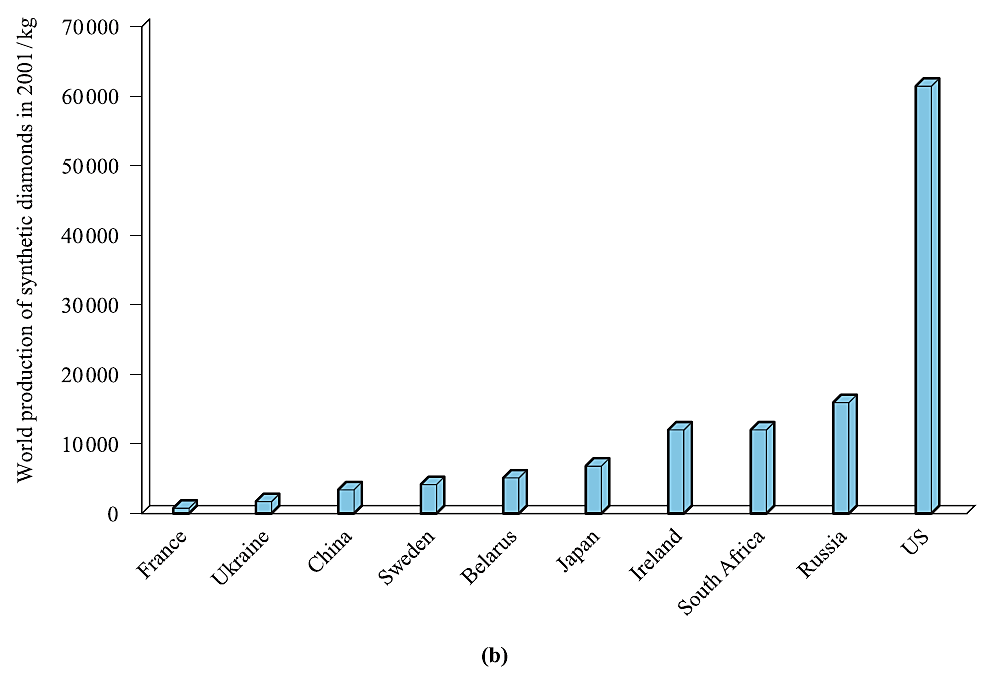
Diamonds: gemstones and more The commercial value of diamonds as gemstones is well
 المؤلف:
CATHERINE E. HOUSECROFT AND ALAN G. SHARPE
المؤلف:
CATHERINE E. HOUSECROFT AND ALAN G. SHARPE
 المصدر:
Inorganic Chemistry
المصدر:
Inorganic Chemistry
 الجزء والصفحة:
p 346
الجزء والصفحة:
p 346
 2-2-2018
2-2-2018
 1905
1905
Diamonds: gemstones and more The commercial value of diamonds as gemstones is well
recognized, and the world production of gem-quality diamonds in 2001 is shown in chart (a) below. The chart also shows the production of diamonds (non gemstone quality) used for industrial purposes. Because diamond is the hardest known substance, it has widespread applications as an abrasive and in cutting-tools and drill-bits. These applications extend from drill-bits for mining to diamond saws for cutting crystals into wafer-thin slices for the electronics industry. Diamond exhibits electrical, optical and thermal properties (it has the highest thermal conductivity of any material at 298 K) that make it suitable for use in corrosion and wear-resistant coatings, in heat sinks in electrical circuits, and in certain types of lenses.
An application in the laboratory is in diamond anvil cells in which diamonds on the tips of pistons are compressed together, achieving pressures up to 200 GPa. Such pressures are comparable with those in the center of the Earth. A stainless-steel gasket placed between the diamonds provides a sample chamber. Diamonds are transparent to IR, visible, near- UV and X-ray radiation, and therefore diamond anvil cells can be used in conjunction with spectroscopic and X-ray diffraction equipment to study high-pressure phases of minerals. Industrial demand for diamond is met in part by synthetic diamonds, the 2001 world production of which is shown in chart (b). Under conditions of pressures greater than
12.5× 103 MPa and a temperature of ≈ 3000 K, graphite transforms into diamond. Synthetic diamonds are produced by dissolving graphite in a melted metal (e.g. Fe) and crystallizing the mixture under appropriate high P and T conditions. After being cooled, the metal is dissolved into acid, leaving synthetic diamonds of sizes ranging between ≈ 0.05 and 0.5 mm. Major uses of these industrial diamonds include grinding, honing (e.g. smoothing cylinder bores), saw-blades and polishing powders. The relative importance of synthetic diamond production (which has risen dramatically since 1950) compared with mining of the natural material is clearly seen by comparing the scales of the two charts below. The US leads the world in the manufacture of synthetic diamonds, while the main reserves of gemstone diamonds are in Africa, Australia, Canada and Russia; exploitation of the Canadian reserves is being expanded and the first underground diamond mine should begin production in 2005.


 الاكثر قراءة في مواضيع عامة في الكيمياء اللاعضوية
الاكثر قراءة في مواضيع عامة في الكيمياء اللاعضوية
 اخر الاخبار
اخر الاخبار
اخبار العتبة العباسية المقدسة


